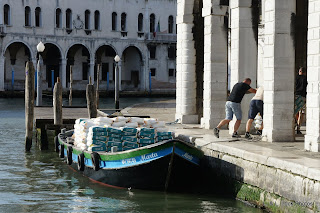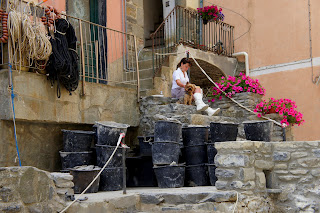 At six in the
morning I can hear the tired engine and the loud exhaust sounds of the muffler-less
municipal garbage truck. The crew
operating the garbage truck are currently only two houses south of ours. I have to hustle to get the can out on the
street before they pass us by. The guys
wave and holler a greeting as the truck slowly rolls up to our curb. One worker tosses the full can high into the
air, towards his buddy who is perched atop the myriad of reeking plastic bags
and cardboard boxes.
At six in the
morning I can hear the tired engine and the loud exhaust sounds of the muffler-less
municipal garbage truck. The crew
operating the garbage truck are currently only two houses south of ours. I have to hustle to get the can out on the
street before they pass us by. The guys
wave and holler a greeting as the truck slowly rolls up to our curb. One worker tosses the full can high into the
air, towards his buddy who is perched atop the myriad of reeking plastic bags
and cardboard boxes.
Our can is emptied,
and carefully placed back on the street right-side up with lid affixed. They laugh, joke with each other. One guy sings bits of a song that could be
ribald, off-colour judging by the way it makes the others giggle.
It's good to be back on Isla.
During May and June we traveled for six weeks through Dieppe, Vimy Ridge, Dunkirk, the Loire Valley, Paris, southern France, Cinque Terre, Tuscany and Venice before returning home via London. We mangled several languages, speaking a combination of French, Spanish, and English with the odd word of Italian tossed in the mix for that truly continental sound. We ate delicious food, but missed the 'heat' - the spice of Mexican foods. Apparently our palates have adjusted to Mexican food better than we thought.
We drank different wines and beers, enjoying Belgium beers and French wines a bit more than German beers and Italian wines. We dealt with crowded underground transit systems, high-speed trains, city buses and commuter boats. And the crowds. Line-ups to see museums. Line-ups to get on the trains. Line-ups everywhere!
The sights, the sounds, the smells - all different. New. Exciting.
Now, sitting on our street-side balcony we watch friends speed past on their motos or golf carts. They yell hello, welcome back, and wave as they speed past. Sue Lo, on her daily walk around the airport, stops to chat - recounting her recent adventures in Machu Picchu.
 |
| Fashionista riding a bicycle in Paris - K Lock Photo |
A motorcycle slowly putts past with two adults - the woman clutching onto a little one, so small that one tiny foot with a yellow bootie is all that is visible.
A young girl, standing in the foot-well of a motorcycle turns to chat with her dad as he drives her somewhere special. She is wearing a pink and white polka-dotted dress and a matching bow in her hair.
Her happy smile is wide and loving as she looks at him.
The contrast between the Isla motorcyclists and the Armani-suited motorcyclists or the beautiful fashionistas riding bicycles in Paris is startling to say the least.
In the evening we sit on the east side of the house, wine glass in hand, staring at the turquoise ocean, aware that we missed this most of all. The colours. The sounds. The smell of the water.
We will always be proudly Canadian, but, Mexico is now home.
___________________________
This is the last posting for this blog. Please join us on our other weekly blog Notes From Paradise - living on an island in the Caribbean Sea on the east coast of Mexico.
http://lynda-notesfromparadise.blogspot.mx/



















































